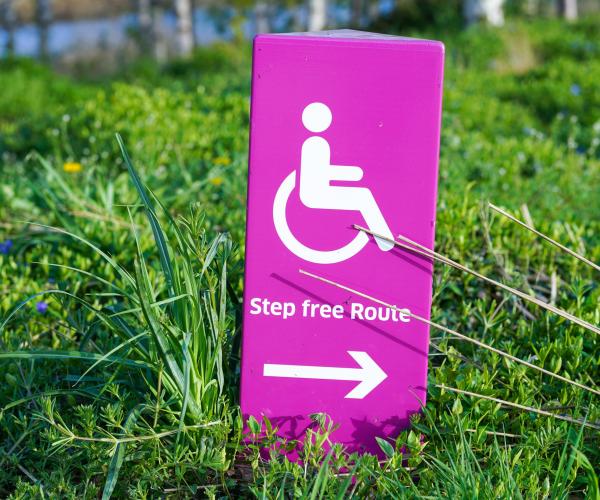Website Accessibility - Disabilities on the Web


When it comes to the Internet and your website, the thought of individuals with sight disabilities should come to mind. There are many other disabilities, however, that can make using the Internet difficult for individuals. I do want to note that we are NOT lawyers and can not provide legal advice.*
There are guidelines set by the Americans with Disabilities Act (ADA) that help website developers understand what elements may be difficult for those with disabilities. By following their guidelines, a website can be ADA compliant. Click here to read our blog that discusses ADA Compliance in depth.
Being ADA compliant isn't the only reason you want your website to be easily accessible to those with disabilities. You want as many people as possible to be able to enjoy what you have to say and have access to what you have to offer. Knowing how certain disabilities affect the user experience for these individuals can help you make better choices and ensure your website is accessible to the greatest number of people.
Cognitive Issues
 Not all brains process information the same way; cognitive issues take many forms. One person may have dyslexia or dyscalculia. Another may have a very short attention span that makes staying on track difficult. Others can grasp information only if it is presented in small bits. All of these people can find it difficult to find the information they need if they have to wade through long paragraphs with little white space, have to focus on deciphering an unusual font, or face website pages that aren't consistent in layout from one page to another. You can make your site more accessible with a few easy measures.
Not all brains process information the same way; cognitive issues take many forms. One person may have dyslexia or dyscalculia. Another may have a very short attention span that makes staying on track difficult. Others can grasp information only if it is presented in small bits. All of these people can find it difficult to find the information they need if they have to wade through long paragraphs with little white space, have to focus on deciphering an unusual font, or face website pages that aren't consistent in layout from one page to another. You can make your site more accessible with a few easy measures.
Stick with short paragraphs that offer many natural breaking points so the reader has time to process each bit of information before moving on. A good way to do this is to create content in list form. ADA compliant websites also stick to the same format throughout. If your menu is on the left on your first page, place it there on every page. Make sure every page has a clear way to return to your main page. Finally, make as much information available on the page as possible. Don’t require the visitor to download something if you can place the information easily on that page. If a download is required, place it at the end of the page so the visitor can concentrate on what information you can provide before having to perform another action. Keep things clean and easy.
Voice Difficulties
 Voice recognition software is becoming increasingly more popular. No longer are we required to just type in a particular search request. We can ask Google to play a song and it starts playing. But imagine what would happen if you stuttered or had a speech disorder that made it difficult to pronounce words clearly. There are some individuals who have a problem that makes it difficult for their mouths to form the correct sounds that their brain is thinking. For these people, having to talk on the phone or navigate by voice becomes a nightmare.
Voice recognition software is becoming increasingly more popular. No longer are we required to just type in a particular search request. We can ask Google to play a song and it starts playing. But imagine what would happen if you stuttered or had a speech disorder that made it difficult to pronounce words clearly. There are some individuals who have a problem that makes it difficult for their mouths to form the correct sounds that their brain is thinking. For these people, having to talk on the phone or navigate by voice becomes a nightmare.
Don’t fret! It’s actually pretty easy to make your website a positive experience for people with these types of disabilities. Make sure you have a clearly placed search box and include a FAQ page with the answers you find are most often needed. These should be easily accessible along with your general navigation. One of the greatest things you can do is provide more than one way for a visitor to contact you. Include a phone number, but also consider a chatbot and email address. Our website has all three options.
Seizure Triggers
 One disability that is addressed in ADA compliant protocol concerns seizure disorders. This is a disorder many of us don't think about unless we know someone who is easily triggered or experiences this ourselves. You want people to experience content on your website that is engaging. You may want to create a bright, happy place with bright colors and a lot of action, but if you’re not careful this could potentially trigger a seizure in some individuals. These people may end up with a migraine, find themselves dizzy or nauseous, or have a full-blown seizure. What can you do to help reduce this possibility?
One disability that is addressed in ADA compliant protocol concerns seizure disorders. This is a disorder many of us don't think about unless we know someone who is easily triggered or experiences this ourselves. You want people to experience content on your website that is engaging. You may want to create a bright, happy place with bright colors and a lot of action, but if you’re not careful this could potentially trigger a seizure in some individuals. These people may end up with a migraine, find themselves dizzy or nauseous, or have a full-blown seizure. What can you do to help reduce this possibility?
The first thing you can do is to become aware of what specific elements are most likely to cause a seizure. This includes flashing lights, too many changing colors in succession, bright lights, and a lot of motion. Though you don't have to avoid motion altogether. Ask yourself if your website is too bright. There is bound to be an ADA compliant option that still produces the overall look you are seeking. If there is a lot of movement, offer visitors a way to turn that motion off or have it disabled by default. Make sure that the information they may have gained by watching is available in another format, such as text. Finally, place a warning at the top of your page where it can be easily seen that says that there are elements on the page that may trigger seizures. If there are other options available, make that fact known with this warning.
Hand Motor Skills Limited
 We take for granted the ability to type a term in a search box, but for a growing portion of the population, things like arthritis and other joint disorders make typing painful. Another part of the population is made up of people who have no control over fine motor skills. These are people who may need alternative methods to operate keyboards or even a mouse.
We take for granted the ability to type a term in a search box, but for a growing portion of the population, things like arthritis and other joint disorders make typing painful. Another part of the population is made up of people who have no control over fine motor skills. These are people who may need alternative methods to operate keyboards or even a mouse.
While you can't do a great deal about this from your end, there are apps available to help make the navigation of websites easier for individuals with limited hand motor skills. These apps include voice recognition, eye movement navigation, and many other features. What you can do is research what apps are available and make sure your website is compatible with what is listed. If possible, consider what may be available in the near future and seek a design that can be altered easily to include compatibility with those to continue to keep your website ADA compliant.
Sight Issues
 Sight issues can come in many forms. For now, we will concentrate on low vision, which is the need to wear glasses or to have no vision at all. When a website is too full, it can make it difficult for people who have trouble seeing to separate the information because everything blends together. Other people need to use braille readers or other readers that do not recognize visual elements such as photos. There are a few ways you can remedy this.
Sight issues can come in many forms. For now, we will concentrate on low vision, which is the need to wear glasses or to have no vision at all. When a website is too full, it can make it difficult for people who have trouble seeing to separate the information because everything blends together. Other people need to use braille readers or other readers that do not recognize visual elements such as photos. There are a few ways you can remedy this.
First, make sure your website keeps a consistent look across a number of browsers and devices. This way, the greatest number of people can easily see it on the devices they use most often. Allowing people to change the font size as needed is another easy step that can be taken. It also helps if you keep your font plain and at least 12-point in size. Keep backgrounds plain so they don't distract from the content. An important measure you can also take to remain ADA compliant is to make sure that all pictures and charts, which are not recognized by Braille readers, have alternative text that describes the content as clearly as possible.
Hearing Difficulties
 Hearing difficulties can range from hard of hearing to being completely unable to hear sound. This can be a problem when there is video content on your website that conveys a large amount of information.
Hearing difficulties can range from hard of hearing to being completely unable to hear sound. This can be a problem when there is video content on your website that conveys a large amount of information.
Providing the ability for closed captioning is one of the most common ways of remaining ADA compliant and allowing visitors to know what your content is about. Another option is to provide transcripts that can be easily accessed by visitors. This allows the individual to know exactly what is being said in the video. A third option is to provide a sign language version of the material that can be accessed upon request. By providing these three options, or at least one of them, you give those with hearing difficulties a chance to enjoy their visit to your site.
Involuntary Motions/Tremors
 Conditions such as total paralysis, Parkinson's and Cerebral Palsy all make it difficult for an individual to use a conventional keyboard and mouse to navigate the Internet. These conditions cause the hands to shake, twitch unexpectedly, or not move at all.
Conditions such as total paralysis, Parkinson's and Cerebral Palsy all make it difficult for an individual to use a conventional keyboard and mouse to navigate the Internet. These conditions cause the hands to shake, twitch unexpectedly, or not move at all.
There are two things that can make the website more accessible for individuals with these types of motor disorders. The first is to allow for voice command navigation through third party systems such as Handsfree for Web. The second thing you can do is to make sure your coding allows compatibility with other voice-activation devices, eye-movement navigation, and specialty keyboards.
Neurological Disorders
Neurological conditions are those that make using the Internet difficult because they cause confusion, frustration, or are generally overwhelming to individuals. People with neurological disorders may not have the patience to try to figure out complicated navigation. Making your website less complicated is the key to helping these individuals have a positive experience.
A simple design is often priceless in regards to a website. Keep navigation simple, making it possible to find information easily. Make sure all the pages are set up the same and there is access to the Home page on every page. Display content in a way that makes sense and provide plenty of white space to prevent all the information from becoming jumbled.
Repetitive Motion Disorders (RMD)
 The most notable repetitive Motion Disorder is carpal tunnel syndrome. This disorder increases over time and makes navigating the Internet painful. People with RMD usually have to deal with their disorder themselves, for example using specially-designed keyboards. As a website owner, however, you can help.
The most notable repetitive Motion Disorder is carpal tunnel syndrome. This disorder increases over time and makes navigating the Internet painful. People with RMD usually have to deal with their disorder themselves, for example using specially-designed keyboards. As a website owner, however, you can help.
Create a website where information can be accessed with as few motions as possible. If you can get your visitor to their information in one click, don't make them use two or three. Providing voice to text options will also make it unnecessary to use as many hand motions.
Inability to Speak
 We already addressed disorders that make forming words difficult, but what happens when a visitor to your website is unable to communicate through speech at all. This is referred to as mutism and is one of the categories you should consider when creating an ADA compliant website.
We already addressed disorders that make forming words difficult, but what happens when a visitor to your website is unable to communicate through speech at all. This is referred to as mutism and is one of the categories you should consider when creating an ADA compliant website.
One of the biggest things to have in place is a way for your visitors to communicate with you through writing. This can include an email contact form, or a chatbot. Where forms are concerned, make sure they are easy to understand and provide instructions in both written and audio formats in case there is a question on how to proceed. Not having a way to effectively communicate is one of the most frustrating things a website visitor can experience.
Color Issues
 Color-blindness affects a full eight percent of the male population and 1 in every 200 women. This disorder makes it impossible to distinguish certain colors, such as red and green. These colors appear as grey and can blend into one another. Another form color-blindness can take is being unable to distinguish blues and greens or blues and purples from each other. A smaller percent of the population can see no colors at all except for shades of grey, black, and white.
Color-blindness affects a full eight percent of the male population and 1 in every 200 women. This disorder makes it impossible to distinguish certain colors, such as red and green. These colors appear as grey and can blend into one another. Another form color-blindness can take is being unable to distinguish blues and greens or blues and purples from each other. A smaller percent of the population can see no colors at all except for shades of grey, black, and white.
In addition to choosing colors that are high contrast for your design, there is one additional measure you can take to allow easier access to your website for individuals with color issues. Provide a way in your coding that allows visitors to choose the colors they will be viewing your website in. This would be especially helpful for the background but is also necessary for font.
Multiple Disorders
 For some people, navigating a website becomes even more difficult because they are dealing with more than one disability. For example, they may have been born color-blind and as they got older, they develop fine motor problems or they start to lose their hearing. The challenges become compounded.
For some people, navigating a website becomes even more difficult because they are dealing with more than one disability. For example, they may have been born color-blind and as they got older, they develop fine motor problems or they start to lose their hearing. The challenges become compounded.
By creating an ADA compliant website that incorporates as many accommodations as possible, you make the user experience more productive. Keep navigation simple and straight-forward, making everything easy to find. Give your visitors options to customize their experience in a way that meets their individual needs.
Situational Disorders
 Many individuals don't think about how others experience a website until they find themselves in a situation where they are temporarily disabled. This could be as simple as riding on a subway and not being able to listen to a video. Thus having closed captioning on said video would help. When this happens, they may become even more frustrated by the inability to access information that was easy to access before the temporary disability hit. Your foresight in already having measures in place for those who experience these disabilities on a regular basis will make it easier for those in temporary situations. An ADA compliant website isn't just a legal requirement, it is a human necessity in today's society.
Many individuals don't think about how others experience a website until they find themselves in a situation where they are temporarily disabled. This could be as simple as riding on a subway and not being able to listen to a video. Thus having closed captioning on said video would help. When this happens, they may become even more frustrated by the inability to access information that was easy to access before the temporary disability hit. Your foresight in already having measures in place for those who experience these disabilities on a regular basis will make it easier for those in temporary situations. An ADA compliant website isn't just a legal requirement, it is a human necessity in today's society.
 ADA compliance may feel like just another legal requirement, but it is so much more. By following the guidelines set by the ADA, you are showing your visitors that you care about them as individuals. You are making your website a place where people with many types of disabilities don't have to experience yet another instance of frustration and exclusion. They will feel welcome and this will reflect positively on you.
ADA compliance may feel like just another legal requirement, but it is so much more. By following the guidelines set by the ADA, you are showing your visitors that you care about them as individuals. You are making your website a place where people with many types of disabilities don't have to experience yet another instance of frustration and exclusion. They will feel welcome and this will reflect positively on you.
Your website is your presence on the Internet. It is in many cases the only representation of you and what you have to offer. Take a look at each of the items above and put yourself in the shoes of an individual with that disability. From that perspective, how does your website measure up and what can you do to increase that standing?
*Legal Note:
This post was created with our clients (existing and potential) best interests in mind and intended to inform them of the potential liability of not having an ADA/WCAG compliant website. The info in this post is believed to be true at the time of posting. As the ADA/WCAG landscape is changing constantly the information in this post may become out of date. If you believe that any of the info in this post is out of date please contact us and let us know. We can not be liable if you do or do not act on any information within this post.
